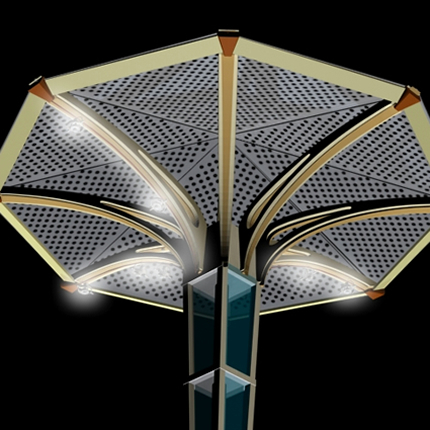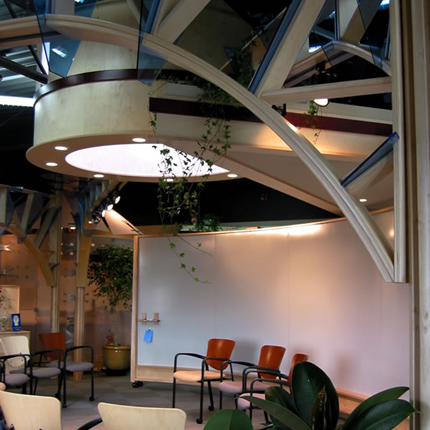the Making, Ownership and Use of navCenters |
click on drawings above for background on the projects illustrated |
how to conceive and realize a new armature for creative work |
| Building the UniCredit navCenter, four years ago as I write this in 2010, was an amazing experience and the opportunity to implement some ideas that had long been in the “someday we can do this” bucket. At the time, the Turin project was a big stretch for all of us, UniCredit, architects, contractors, suppliers and our own AI shop. The creative collaboration necessary for getting it done on schedule produced some amazing moments of design, engineering and building synergy. |
| I use is Turin as a Template for this documentation because it illustrates capabilities still uncommon to the general practice of building navCenters, and while still not yet fully employed in its own daily practice, these capabilities are clearly necessary to accomplish the work inherent in large scale, complex, long duration projects of the near future. This center cost more for a variety of reasons, a compressed design-build cycle chief among them, than what I represent on the capital cost schedule of page 1. What I show for this class of center can produce 95% of Turin, to a far more practical result, and still achieve the magic that this environment has while radically reducing the complexity that the circumstances surrounding this work imposed on the design/build/use team. Advances and cost reduction in technology, the more friendly U.S. building regulatory environment, an aggressive yet reasonable build cycle time, and a less technically challenging building shell to restore, will result in the costs represented. |
|
| Turin advanced the building practice of navCenters in several areas. First the use of vertical space. It is rare that a room with this much open height is available. It allows the same sense of space and use of space vertically as it does horizontally. I am exploring the same kind of vertical awareness with the (project # 196) Circle of Blue design. The use of PODs and a true planed, growing interior landscape, while not as extensive as the 2003 Childrens Hospital design (project # 117), is to this day the most extensive representation of it we have built to date. It is in the realm of multimedia capability, however, that Turin presents its greatest potential, and so far, largest disappointment. |
| The Unicredit navCenter has a studio quality real time video capture, editing and playback ability, with over 40 screens in the main space which can receive 8 different feeds at any time, individual control over 400 lights and enough hard disk space to store days of data without making a dent in its capacity. Unfortunately, the final step in the installation was never made which was to program the system so that it could be run by KnowledgeWorkers with a few wireless PCs. This failure means that the full power of the system is rarely used because of professional staffing requirements. It is a design rule of ours to never create a technical system that the average skilled KnowledgeWorker cannot run themselves. This one slipped through the cracks. |
|
 |
| UniCredit has a grand Radiant Room in which a team of 5 can sit in the center in comfort yet 400 can assemble so that no one is more than 10 rows away from the speaker using a “theater-in-the-round” set up. Within minutes, the space can be reconfigured into work team areas. Because of the constraints of a very beautiful 19th Century building which was preserved for this reuse, the actual number of users in collaborative team and projects work modes is limited to about 75 to 100. In a more typical space, with the square footage noted on the page 1 schedule, this number can be doubled. |
| These qualifications aside, which were driven by circumstances - and not necessarily bad ones - far removed organizationally from those conducting the project, the UniCredit navCenter points the way to what a regional scale facility needs to be in order to do the work of this era. It creates a space to think, learn and work, provides a high level of amenity as well as setting historical context, supports, surprises and delights those who use it in ways that very few workspaces aspire to. It is unique in the world, has been called the most sophisticated meeting place in Europe, and I expect it to keep on evolving for a long time. |
| Turin points the way to several important goals: That one environment can support all the modes from conventional presentation seating to radical collaborative group processes. That older buildings can be preserved and re purposed without compromise and that several “styles” of architecture can be integrated into a single, warm, inviting and exciting experience which in itself conveys a strong statement of an organization’s intent and brand. That even in the center of a dense city, nature can find a significant place and role to play. That the extreme flexibility required by a multi-venue program can be accomplished without sacrifice to any of the uses. That by merely walking through a door from a busy urban setting, in a few paces one can be transported into a completely different sense of time and space. |
| The Turin navCenter is about to be joined soon with the second node in the UniCredit system. I facilitated a DesignShop a few months back for the design of the Vienna navCenter to be built in a recreation area on the bank of a river. This is the first expansion of the UniManagement system and it is expected that there will be more throughout Europe as UniCredit’s goal is not to be an Italian bank with branches in other countries but the first true European bank. |
|
|
click on graphic to return to page 1 |
|
specifications for a regonal navCenter as ValueWeb hub for multiple local centers |
| At the MG Taylor navCenters we say “that everything speaks.” Everything. There is nothing that is devoid of meaning and does not impact us. Go to a well done modern movie and instead of getting into it retain your observer mode and look at how the first few opening minutes are treated. This is call exposition. The mood, context, theme, often major players have to be established and you the viewer drawn into this made up world. If the work is done well, you accept this fantasy and relate to it, and respond to it, emotionally and intellectually. Notice, however, that all you are perceiving are some flickering lights of various colors on a screen and sounds projected out into the open space of the theater. These sensations are being connected in various, associative and distributed ways to your memory: the sum total of your life experience up to this moment of new perceptions. |
| Employing the skills of their art, the film makers convey a dense integrated mixture of words, images and music, which precisely covey the experience they which you to have. This can be transformational, shocking or annoying, yet is rarely dull. It is true that every movie goer responds differently according to their prior experience, beliefs, present mood and a variety of other factors. This just make the movie makers success all the more remarkable when they succeed in producing an experience which millions, all over the world, want to have and have again over many decades. This speaks to the universality of art and also to the large degree which some humans actually understand Humanity. The successful movie maker knows that “everything speaks.” The cuts between the scenes; the symbols employed; the viewpoint of the camera; the music; the pace of the movie; the connotation and denotation of words and how they are spoken; the lighting and colors; the setting of the scene; all these factors and many more form a gestalt. A gestalt that for a period of time you will accept as reality and let impact how you feel and think. |
| Every detail of a film is carefully chosen. Everything is the product of a design process which has the intent to deliver a result of a certain kind as well as an indefinable, not predictable nor controllable emergent consequence. If you study carefully how films are made you will derive a great deal of understanding of not only how art works but also how does human life. |
| The film, for a period of time, becomes the viewer’s environment. navCenters are environments designed to properly hold the appropriate context, and supply just in time the appropriate too kit for the emergence of creativity, collaboration, innovation and GroupGenius®. |
| It is sometimes said that it is difficult to express exact meaning in architecture. The answer is that it is impossible not to. |
| The entry process is a ritual. The street is a transactional environment of many moods. For most of the day it is busy, noisy, often exciting and crowded. People spend a great portion of their days and lives in transactional mode: getting here and there, multitasking, making decisions, moving from place to place, meeting to meeting. This is how a great deal of the world’s business gets done. This is not the best mental space for learning, thinking, planning, designing, creating strategy, or developing wisdom. The full creative process from the inception of an idea to its realization involves many steps and many skill sets. Each of these involve a different mentality. With any complex problems this variety exceeds the range of a single individual. Collaboration - which is not mere cooperation - is required. Complex issues require the knowledge and skills of many and the vantage points of different philosophies and cultures. This is immense variety. The workspace has to match this variety to support it. This is cannot be a hodge podge of jumbled elements functioning at random. It is an orchestra. Yet, not one that plays the same music over and over. The music emerges as a consequence of the work unfolding while creating the frame which contains the variety of the work. This is the creative process operating on several levels of recursion and iterations at once. The environment is literally the physical manifestation of the work process which takes place within it. |
| It should be noted, that the statement above is true about all workplaces. When you look at the default standard workplace, this statement should give you pause. It is often argued that “we” cannot afford a workplace designed for knowledge work, design and collaboration. If we can afford the typical workplace of today, we can afford anything. The “office” is now the center of production in both the local and global economy and it is decades behind where it should be. NavCenters are special places to work. A concentration of means to support creativity and innovation and the production of mental goods. The goal is for this to cease be an unique case. The goal is to establish navCenter nodes in a ValueWeb which is investment, creation, production and market as one system. This is true if the goods be a new computer system, a play on Broadway, a social movement, a scientific breakthrough, the creation of a new form of affordable, sustainable housing, a global energy policy, an education system and method that works, or whatever goods some one wants to make. The systemic issue is that it is critical that these “goods,” in realty, are good. |
| It is a navCenter’s active participation in a ValueWeb of appropriate critical mass and mix of nodes which provides stability to the system. This helps ensure that the goods shipped are indeed good. This means that ValueWeb members cannot be all of one kind. An oil company is likely to create more value by being linked to environmental groups than only other oil companies, government regulators and the Chamber of Commerce. NGO's with corporations and visa versa. There is a tendency to design our networks with those we already agree with thus reinforcing our existing virtues and faults. Our society generally understands the risks inherent in “closed minds” yet rarely acts to open them. When I describe a navCenter, from the scale of a small workspace to its global ValueWeb as the “mind of the organization,” I an not speaking metaphorically. I mean it literally. When I describe memory as state 1, state 2, state 3 ...n of the entire system, I am not speaking metaphorically. I mean it literally. Just as we have to be aware, and self critical (the executive routine) in how we assemble our mental information, principles, beliefs, tool kit and practice habits, so also we have the do the same in the design and construction of our enterprises. Just as we cannot understand or totally control our brain-mind system, we cannot understand and control our enterprises nor the markets and social, political, economic, ecological systems which they are a part. This means we have to have a design strategy which guides us on how we engage with complex, emergent systems. |
| When you are designing or impacting a part of a system, you are designing the system - and visa versa. And, so is everyone else who is a part of that system. That system can be seen as a repeating pattern language from the neural net of your brain-mind to Gaia as a Earth system in a planetary system (to keep it to a simple view). While the real world is more complex than this, the core of the Taylor System and Method is to focus on the Agents of a system, how they engage and interact on any recursion level of that system, at any time, and the rules they execute while doing so. The focus is how learning, creativity, collaboration and innovation emerges as a consequence of these interactions. At any given moment, the Agents engaging are in the Field of Emergence which is the center of the 7 Domains Model of the Taylor System. These Agents are “brought in” to this field by specific terms-of-engagement and facilitated by the functioning of the total environment (in context of this writing, the navCenter and its ValueWeb) provided through the length of the engagement. At the “end” of this engagement, or a phase of it, the Agents “exit” the Taylor system and act in their now altered system which provides information and feedback to the Taylor System and Method. The navCenter functions by employing, itself, the same methods and means it provides to create the Zone of Emergence environment for those using the navCenter. Its navCenter experience is similar to the users experience just on a different recursion level, with a different task and at an iteration “ahead” of theirs. In each engagement, the ValueWebs of all participating change and expand. The Taylor Method is a biomimicry/organic design strategy to engage not predictable complex systems in a way that reduces time, increases beneficial results to the entire system-in-focus, and reduces unintended negative consequences, while better connecting the system-in-focus to the relevant systems within it and to which it is a part. While this is what everyone does when they work smart and well, the Taylor Method is a formal, transferable process which does this with a high level of reliability and reduction in error, pain, and sacrifice of living beings. This is a transition strategy to help facilitate “leaping the Abyss” between a dying scientific-philosophical, economic, social paradigm and a new paradigm which is just coming into resolution. |
| The navCenter is both a tool of transformation and an-example-of-one of a practice exemplary of some aspects-coming-into-being of this new paradigm. Thus, it is a work of living art, a laboratory, and a rapid prototyping system. As a transition manager support system, the navCenter has to maintain competency in both paradigms in order to achieve it’s mission and maintain economic viability while doing so. |
Specfications of a Regonal scale navCenter: |
| Given the nature and Mission of a navCenter and the qualities of a Regional Center, and the strategy of creating a viable web of Centers, the performance specifications for a Regional NavCenter are: |
| design and operate the Center to represent, symbolically and functionally, the region of it’s location |
| make the Center a hub in a ValueWeb of centers of excellence of many kinds |
| provide navCenter access and services to key replacement economy and transformational focused enterprises of the region |
| have one to three core competencies in areas systemic to the region’s replacement economy and also to connected and persistent global issues |
| have a state-of-the-art RemotePresence and Collaboration capability with broad bandwidth capable of real time interaction with a minimum of 30 nodes |
| partner and co-locate with an institution with a different agenda yet compatible mission and complimentary resources |
| establish an ownership and governance process which does not compromise the functionality and neutrality of the navCenter nor subject it to “food fights” with members of it’s ValueWeb first two Clamshells |
| build and transfer Type 5 processes, to satelite nodes within the navCenter’s ValueWeb Inner Clamshells |
| Transfer capability and pass mature work to qualified ValueWeb members thus constantly freeing organic navCenter talents and resources to create and take on newly forming work relevant to the owner-operator’s mission |
| develop and operate an active PatchWorks architecture networking system throughout the scope of the greater ValueWeb |
| For a 21st Century enterprise, the resources and capabilities which are inside the legal, organizational skin - as traditionally defined - of the enterprise are not sufficient for the enterprise to achieve it’s objectives and mission. A complex enterprise in a complex environment has to attract, nurture and create a ValueWeb, work to make it viable, and adapt to be fit within this evolving economic-social ecology. This requires a completely different organizational strategy then typically was the task in the 20th Century. The performance specifications, listed above address some of the greater ValueWeb requirements. Below are requirements for it’s physical operating environment: |
create a minimum of five zones which can open and close to one another in various combinations as required: reception-“administrative” - KnowledgeWorker; large group area; small group area (with RDS components); projects area; private, individual study-work areas |
distribute zones with multiple Patches of each type connected by “roads,” “walks,” “alley ways” and Armature elements |
apply all relevant Pattern Language principles |
| employ multiple levels to create a varied vertical space and allow clusters of adjacent sub-areas and zones |
| Additional to these generic specifications, there will be specifications specific to a given region, the requirements of the owner-operator of the Center, and the unique aspects of it’s core mission. |
| select the navCenter location to bind the Center to the history of it’s city-region and to be accessible to core societal elements of the city |
|
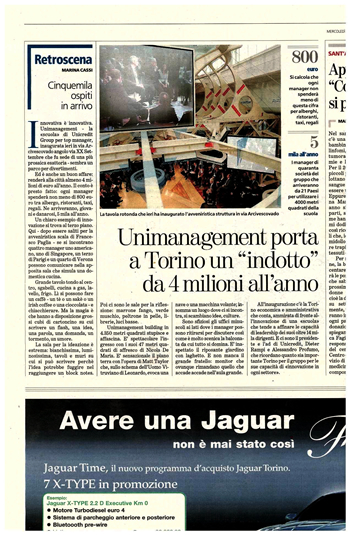 |
| A Regional navCenter acts as a ValueWeb hub for a number of local navCenters and other enterprises of excellence. It is also located with care within the city-region in which it is placed. Unimanagement is the largest bank in Italy and the fourth in the EU. One of its largest owners is a foundation charged with the development of the region around Turin which has long been the center of Industry in Italy. Turin is in the process of becoming a design center as well as a manufacturing one. This is why the foundation, which is also housed in the same building, wanted the navCenter located there. The La Stampa article on the left captures Alessandro Profumo, then CO of Unicredit, and myself presenting the new facility to the mayor of Turin, political and business leaders of the region. The Center was offered to this leadership for use in the transition of Turin from an old style manufacturing region to knowledge-based design economy. This is an organic extension of the banks services and relationship to the European Community. As I write this, nearly four years after its opening, the UniCredit is hosting a session on innovation attended by creatives from all over Europe. |
|
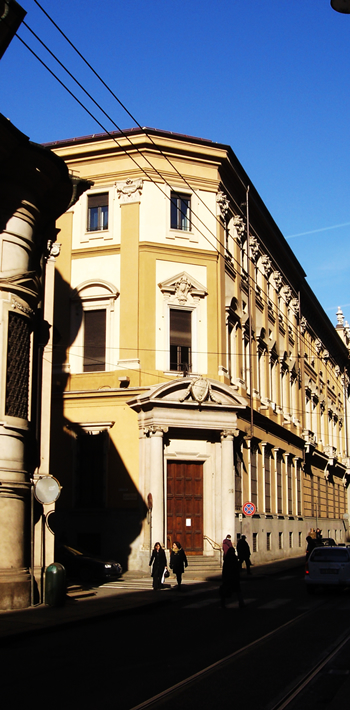 |
| The navCenter is housed in a historic building in the down town section of the oldest part of Turin. At one point this was a bank and it still houses the Foundation. The building is a block long and the navCenter footprint is the half block by half block corner which you see,. The foundation is on the second floor and UniManagement also has the entire third floor which is devoted to learning rooms of various kinds. The first and third floors work as a single system and are connected by glass elevators and stairway which pierce the dome over the large group collaborative area on the first floor. This picture was taken, in January 2006, before the restoration project began. The technology system connects every space on both levels so that anything transpiring in any space can be shared anywhere in the building and elsewhere. What is important about this example is how location and place can deliver a significant message in regards the intent of an organization and about the work which it is doing. In older cities such are found in Europe, Armature as Herb Greene defines it usually exists. In newer places around the planet, Armature has to be created. The creation of physical place in context of historical time for a venue of learning and the deliberate act of recreating the future is a powerful combination which contributes to the formation of StrongMemory. The role of the Foundation and how it came to be, the mission of UniCredit, the transformation of Turin, the design of the interior Armature which is a visual explanation of the history of engineering, all merge into a message that consciously perceived or not cannot be missed. |
|
 |
| The entry rotunda of the navCenter, as it appeared September 2010, acts as a transition zone between the streetscape and the great room under the dome. Security is dealt with as transparently as possible, bags and coats stored and then, upon going through the doors, the floor ramps up around the entry POD and reveals a diagonal view of a world of another kind. Five transitions, each deliberately set for a specific moment in time, designed to leave the outer world behind and open the mind for the explorations to take place. Color, texture, shape, sound - all tunable - become the overture of the experience. The architecture, multimedia, streetscape, landscaping, lighting, art from prior events, books, reveal the beginning of an unfolding story, each time different and specific. Each time universal. The navCenter, in the hand and mind of facilitator-artists, is played like an instrument of delicacy, power ameaning. The medium is the message. The message is to learn and create, to collaborate and play. |
|
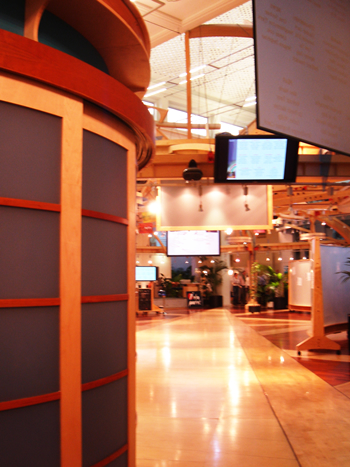 |
| Entering the Radiant Room, September 2010. Properly run, this space will never look the same day to day, hour to hour. It sets the stage for new activities and holds the memory of past work. A navCenter has to function as an organism in an ecology; always, adjusting, changing, adapting to circumstances while being an active agent of causing those circumstances. This requirement demands great attention and not insignificant effort on the part of the resident KnowledgeWorkers. It is a critical in-vest-ment. What is invested is the practice of an art. This is putting intention and energy into the space. It is designing and creating the field-of-Engagement. It is re-member-ing the mission and the focus of what today is the work to be done. This is the architecture of design-build-use. The most creative aspect of architecture is what happens long after the building is built. This is particularly true of making places of creativity, innovation, collaboration and project management. |
|
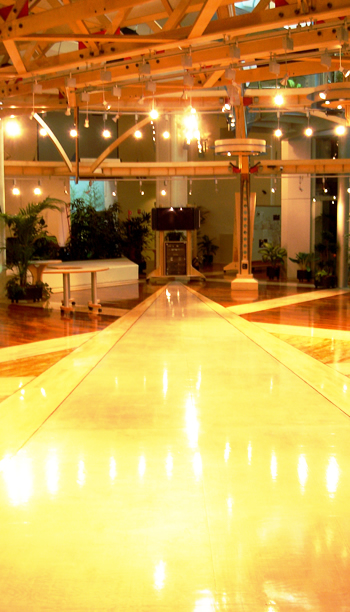 |
| This picture taken in February 2007 shows the Radiant Room in “sleep” mode, with all lights within the 70 foot ring on, at dusk. The space is ready to be set up and “dressed” for a specific set of work tasks. Often this is done in the evening so that the next day is ready early in the morning. The protocol, upon the finish of any work cycle, is to set the room for the next so that users do not come into a muddled space which requires unnecessary effort before their work can begin. Part of finishing a work cycle and “shipping the product” is to reset the space. This is an important commons management principle. While a strong space delivering a clear message about its intended use, in terms of specific messages - in this mode - the message is neutral. It is potential. Graphics, knowledge-objects (Agents), media, the very set of the chairs and WorkWalls themselves, all serve not only the utility support for the work to be done but also express the symbolic and psychological meaning of the work. “Everything speaks.” The building and Armature creates a context. The WorkFurniture, WorkWalls, tools of knowledge work, objects of art and content, how people sit or stand and see-engage one another, the color and texture of materials, the mix of light and shadow, the smell of materials and plants, all sum to a work of art - the background score - which surrounds the work. |
|
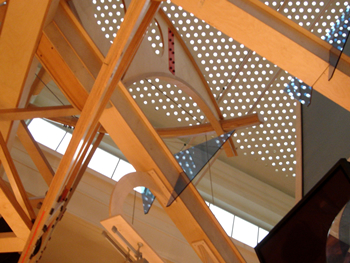 |
| The UniCredit dome over the great room was the first of its kind ever built. With the 360 degree clear story, it supplies a great deal of natural light. The wood Armature carries three and a half miles of wire supplying power, lighting, and connectivity to computer and multimedia technology. Two glass balconies project into the space between dome and Armature as do glass elevators and stairway to the third floor level providing a vertical reality rarely experienced in a workplace. |
|
 |
| At no one place can you stand and see the space whole nor the entire structure of the Armature. The Armature is not the focus of the environment. “Thing-ness” quickly disappears from awareness. Architecture is the background music not the act. The Armature holds the space while everything else changes. The Armature theme is engineering and collaboration. In one direction a pair of simple trusses, the most basic of structural elements. Lateral support is provided by two arched half domes while a suspension structure holds the outer ring, compresses horizontal members and transfers weight to lift the spans deflection. |
|
 |
| With 30 hours to go before opening, the multimedia system is in final testing. Note that the tops of the Armature arch beams are still open for wiring. The viewpoint is from the highest of two glass balconies cantilevered off the stair and elevator core breaking the “flat land” perception and dull uniformity imposed upon those working in the too simple “modern” environment. Looking up or down, at a vista or a enclosed space, at bright and/or shady places, has cognitive consequences to each of us. |
|
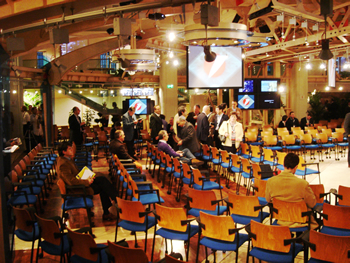 |
| January 18, 2007, the first use of the environment begins. 400 senior executives of UniCredit enter for their semi-annual meeting. Soon, they will surround their CEO and engage in a dialog in the round. Even this, the most traditional of the activities which will take place over the next three days, sends a strong signal that the learning and collaboration work that will take place in this environment is not what they have experienced before. Over three days, this same space will morph many times. |
|
 |
| Taking advantage of the raised Garden POD platform, an excited participant jumped up to make a point. The team had been oriented to a WorkWall on the left. They commandeered a WorkWall that was on the platform and alternated jumping up and down without even bothering to use the ramp and stairs on the side. This generated a great deal of kinesthetic energy in the group an ignited their dialog. As teams were in work groups, during this period, the 40 screens showed multiple views of the Garden which is behind the the POD and runs the length of what once was an exterior wall. This brought a little Nature in and being their first use of the space was our way of letting them know that a “walk in the park” was possible without leaving the space. |
|
 |
| All media is multimedia and every media tool has embedded cognitive biases, strengths and weaknesses. The environment has large WorkWalls, some 32 feet long for working big. At times, the documenting media are square boxes which focus a team’s attention and requires they cluster together as they produce their product for an iteration of work. The boxes can be used for reporting the work and then go out to others teams in support of another iteration of design. Work from different individuals and teams can be combined in different ways showing connections between them allowing synergies to emerge. The boxes are then stacked in the environment, another way to surround the group with their work. |
|
 |
| This used to be a alley between the two buildings. Beyond the glass wall at the end of this picture, the old alley now serves as a back service entry large enough to hold trucks for unloading. Behind, a similar glass wall provides a chase for the new HVAC system, running from the basement to the top, which now serves the entire building. To the left, the openings used to be windows. they have been opened to the ground level. The Garden is under a skylight over the old street and extends through the opening all the way to the Armature truss inside of the original roof. Along the entire length of the Garden water flows, goes under the bridge and terminates in the larger area “inside” adjacent to the garden POD. The entire Garden area is at sitting height above the Radiant Room floor giving the main area a “built into the ground” feeling. Stepping up, or walking up the ramp, to the Garden is a transition to another context. The Garden is as much a function of the mission as all the spaces within the environment. |
|
 |
| The quality of acoustic space and the nuance of sound is often ignored in the workplace. Given the the large volume of this environment there ate still place where the reverberation is still a problem. There are also places where the acoustic signature is excellent. The sound system can be tuned so that how it works though out the space is extraordinary. Over time, a space can to treated so that the sound is a positive element of the experience. There are no short cuts for this and it often requires the subtitle blending of “natural” and technological means. It is important to remember that Nature worked this out a long time ago. Think of a forest and a running brook. Just damping sound, or covering it with “white noise,” is not a solution. A dull acoustic space is as bad as a too active one. We use our senses far more than we realize and it is important not to separate people for reality by denying their full employment. Place is knowing where your are, what your are doing and why, and being fully alive. |
|
 |
| Changes in elevation are discouraged in the modern workplace and this is both unnecessary and foolish. A large space is best organized into zones of different character and functionality even as it works as a whole. Changing ceiling and floor heights to produce the appropriate scale and proportion for the function(s) of a given area is a way of making a “room within a room.” A small change in elevation can create distinction while avoiding seporation. Getting the outer Armature ring to “wrape” the existing columns, merge withthe Pod header, provide for the ADA ramp which follows the curve of the POD, and achieve the intended propirtions of the space required holding dimentioal integrity to a fraction of an inch over the entire space. |
|
 |
| This is where three architectural traditions merge. The 19th Century structure, the pristine glass and steel of the stairs, balconies and elevators, and the organic wood structure of the Armature and WorkFurniture. All respected each other’s geometry and traditions and each blended together to create a single whole. The original great room with its dome and columns still frames the space. The wood floor pattern reinforces the column spacing which stressing their diagonal views. The steel and glass elements float through the space barely touching any wall. The Armature circles the square grid as counterpoint and brings power and multimedia throughout with cluttering the floor plane. If you look carefully at the Armature you will see video cameras, projectors, flat screens, lights, speakers yet, in reality, these are not “seen” until used. 40 screens, 400 lights, 16 speakers, 12 video cameras, miles of wires, 8 projectors and 30 duplex power plugs disappear into this 70 plus foot diameter structure. |
|
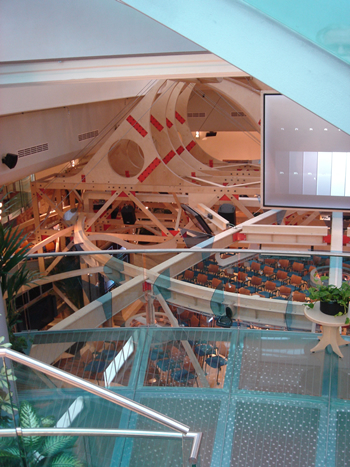 |
| Looking down from one of the three glass balconies provides a different sense of the place. Here it is possible to be of the place yet not caught up in it. This is an important vantage point. Think of the Saturday morning at the terrace cafe with coffee and a good book, newspaper or perhaps computer writing as I am right now. You are in an active social space with a great deal of energy and variety yet “alone” - if you please - able to think, drift off, or work. You are not in your usual environment and, no matter how much you like it your own workspace, a short “vacation” is always in order. There are times in the many processes of learning and creativity where this circumstance is highly important. Awareness of this, and providing the facility for it, is a necessary ingredient of a full dimension workplace and useful in both facilitated and non facilitated experiences. This balcony can be set up as a lounge, an observation platform, with workstations or team design areas. No matter what use, it will maintain its unique perspective. |
|
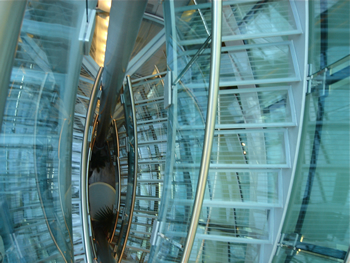 |
| The glass stairway view from top to bottom. Walking from the navCenter to the Learning Center is an exit and entry ritual. Three European floors are closer to five in the U.S.A. The stairs are steel framed and glass, fit between two elevators, and serve two glass balconies along the way. At the second floor level, above the dome, the stairs are encased in glass sides looking into the open court yard and reenter he original building on the third floor. With this transparency, the old and the new fit together. |
|
 |
| Looking up to the balcony and dome reveals the use of prospect and refuge - fixed, and adjustable. No mater where you look in this space there is foreground, middle ground and background with defined spaces (refuge) and spaces of ambiguity (prospect). These spaces have innate cognitive implications as does the act of looking in different directions and elevations. Looking up and to the left into a layered open space or down and to the right at a tightly organized space are different mental acts. |
|
 |
| A space set up ready for work as an invitation to a team . It has, close at hand, the tools necessary for the known task. It invites, by the clarity of its organization, yet also encourages the team to reorganize their place as they see fit. The set ups are shaped so as best to support the task and also to refer to and play counter point with the fixed architectural elements. In this case, you can see the floor pattern which emanates from the columns, which creates a team space module, bisected by the columns diagonal connections. |
|
 |
| Looking from the street-side balcony to the side doors leading to the building enclosed center courtyard. This area is used for food service and provides access to restrooms and the open air protected courtyard. The large wood doors are originals from the 19th Century. The major qualities of the original structure have been preserved and they serve as they have from the beginning. The are many Pattern language values found in the old works which are notable absent from the majority of modern architecture. By integrating the three eras of architecture into one, a rich space is created which contains a wide variety of sub-spaces with unique character and quality. This is necessary to make the right space at the right time for the (typically) 50 to 150 users who will be working in the space at any given time. A few steps around a “corner” and a different sense of place, tool kit, and amenities are provided. Make a few adjustments and it is just right for you and your team. Human made, yet a natural landscape for your purpose. |
|
 |
| A moment of waiting. Above the POD you will see the window of the multimedia editing space. In the control and editing room, there is a monitor for every camera and display screen in the space and the ability to control every piece of equipment and light in use. There is a “hidden” elevator adjacent to the Entry which allows unused WorkWalls, WorkFurniture, chairs and equipment to be easily stored and retrieved. This enables the space to be cleared and seen as open potential - an invitation to be set, dressed and used again in a new way. Open potential, flexible response, constant recreation of the work are critical capabilities and important messages for customers and providers of navCenter services. Just as an individual has to be the future s/he wants to have in order to have it, a navCenter must be the future that is being learned and designed within its place and the network of its ValueWeb. Even good habits can trap us. We need to be able to reset our mental space to open ourselves to new possibilities. |
|
 |
| The PODs open and close with their sliding side panels and also with tops which open in sections. These are “rooms within rooms” which can be set up as an office for one, workstations for three or an intimate meeting room for five people. They can be oriented, open or closed in any direction. The rotation of their floor, and the setting of their panels, are done by hand by those using the POD. The user(s) determine the exact degrees of enclosure or openness, prospect or refuge which is appropriate for them given their mood and task. There are many subtle aspects of environment which effect cognition and the ability to do creative work. While there are many universal aspects common to most individuals, there are many more which are unique to an individual or team which can change at any given moment. It is critical that the environment can be easily tuned to, by minute degrees, to fit the exact requirements wanted at a precise moment. The environment responds to the users and they have a hand in it. |
|
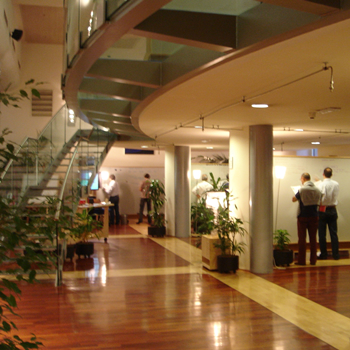 |
| Under the street side balcony, DesignShop participants, in September 2010, are doing “Take-A-Panel” an exercise in which each answers a broad range of questions around an issue providing them the opportunity to focus their individual viewpoints and communicate them before an too early consensus ignores many voices. During this exercise, people can go anywhere in the space and it is always interesting to see how each chooses their place. The room is still and sober at this point as, in this case, 65 members of a large European electronic corporation thinking about their past and future. How the environment is set and what it conveys changes with each module of work. Here it is neutral and at rest. |
|
 |
| The last day of the UniCredit opening ended as it began with Alessandro Profumo in a dialog with his leadership team. The navCenter space helps hold and focus the energy of a group. Its transparent technology deals with the size of this setting enabling anyone who is speaking to be seen and heard by everyone one else in the room - usually from several vantage points - while also viewing any material being discussed often with full multimedia. This is not your father’s Power Point presentation. |
|
| It has always been interesting to me the reason that UniCredit came to me to design the Unicredit Center. They knew nothing about MG Taylor’s work, the DesignShop process nor the idea of navCenters. In 2000 I wrote a paper for a foundation in Baltimore about Building Economy in the Inner City. The paper said a great deal about the roots of innovation. Soon after this, a group in Europe, when responding to a RFP from the European Union, saw the paper and thought it proposed some things relevant to this work and asked if they could use the paper and represent MG Taylor if the idea of a navCenter gained any traction. In this process, the idea of it all passed across the desk of some UniCredit executives. When Anna Simioni was charged to form UniManagement and integrate all of the learning processes across the enterprise she gave me a call. A year later, Turin was in operation. |
| What pleases me is that the Foundation was not aware of any of this when they pushed to have the facility built in Turin. There were many seeds of a similar kind thrown out that sprouted into what now, nearly a decade and half a world away, is the result you see here on this page. The dna is innovation. It is critical, with every project opportunity, to seek the core generator of it and then to use this theme as the integrating principle of all actions which follow. A navCenter has to be designed, built and operated by the same methods which it is charged to employ with its ValueWeb. Ends and means are one and this is true every step of the way. |
|
| A Regional navCenter is a hub - not a control point - in a ValueWeb of Centers, some navCenters, others nodes of excellence of a wide variety of kinds. It is the ability to function in the system integration role that is the key factor. It is a premise of the Taylor System and Method that brains, individuals, teams, group, lagers social organizations, economies and ecologies and the global as a whole all fundamentally function in the same way. The organic components come wired. So far, the human designed components are only partially wired and then based on an old hierarchical model based on power and control. We need to do some biomimicry here. The consequence is that Humanity is designing it’s future by default. The DesignShop, navCenter systems and process are design to be an interim strategy to get enough integration going, long enough, for the emergence of a global organism which works. ValueWebs will form and them merge together. This is the “global brain” so much discussed in recent decades. This does not mean the extinction of individuality nor what we consider our freedoms. It mean the emergence of something new which adds to what we have. |
| Not matter for a local enterprise with a focus on immediate problems or a valueWeb of enterprises dealing with global systemic issues, the navCenter is a design strategy to facilitate transformation on all scales and bridge the existing gap between the complexity we face and the organizational capability we presently have. |
|
posted:
September 14, 2010 • updated October 14, 2010 • 9:16 AM @Elsewhere • 94% complete |
|
|
|
|
Armature |
Appropriate Response |
Types of navCenters |
Vanguard Design |
link coming |
|
|
|
UniCredit navCenter Theme |
Making UniCredit navCenter |
|
|
|
| GoTo Making Owning Use of navCenters |
|
|
|
© Matt Taylor, MG Taylor Corporation, tsmARCHITECTURE, Athenaeum International, all rights reserved
This is intellectual property which constitutes a vested interest in all projects shown |
|
|
